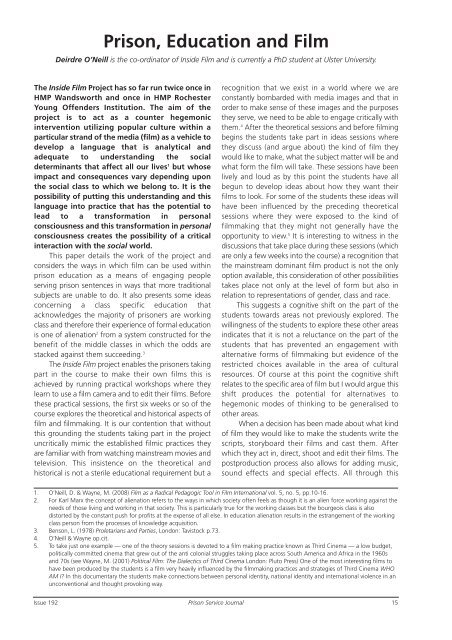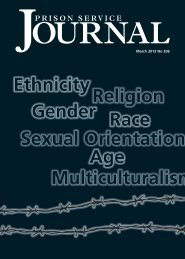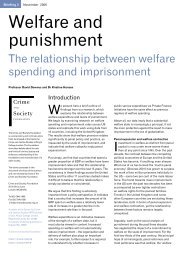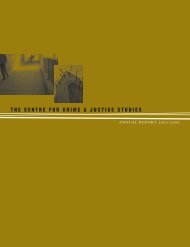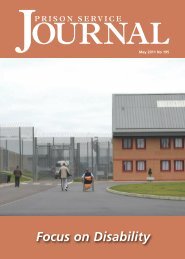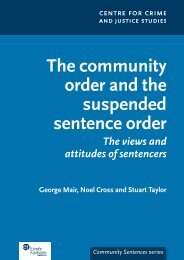PRISON SERVICE
PRISON SERVICE
PRISON SERVICE
- No tags were found...
Create successful ePaper yourself
Turn your PDF publications into a flip-book with our unique Google optimized e-Paper software.
Prison, Education and FilmDeirdre O’Neill is the co-ordinator of Inside Film and is currently a PhD student at Ulster University.The Inside Film Project has so far run twice once inHMP Wandsworth and once in HMP RochesterYoung Offenders Institution. The aim of theproject is to act as a counter hegemonicintervention utilizing popular culture within aparticular strand of the media (film) as a vehicle todevelop a language that is analytical andadequate to understanding the socialdeterminants that affect all our lives 1 but whoseimpact and consequences vary depending uponthe social class to which we belong to. It is thepossibility of putting this understanding and thislanguage into practice that has the potential tolead to a transformation in personalconsciousness and this transformation in personalconsciousness creates the possibility of a criticalinteraction with the social world.This paper details the work of the project andconsiders the ways in which film can be used withinprison education as a means of engaging peopleserving prison sentences in ways that more traditionalsubjects are unable to do. It also presents some ideasconcerning a class specific education thatacknowledges the majority of prisoners are workingclass and therefore their experience of formal educationis one of alienation 2 from a system constructed for thebenefit of the middle classes in which the odds arestacked against them succeeding. 3The Inside Film project enables the prisoners takingpart in the course to make their own films this isachieved by running practical workshops where theylearn to use a film camera and to edit their films. Beforethese practical sessions, the first six weeks or so of thecourse explores the theoretical and historical aspects offilm and filmmaking. It is our contention that withoutthis grounding the students taking part in the projectuncritically mimic the established filmic practices theyare familiar with from watching mainstream movies andtelevision. This insistence on the theoretical andhistorical is not a sterile educational requirement but arecognition that we exist in a world where we areconstantly bombarded with media images and that inorder to make sense of these images and the purposesthey serve, we need to be able to engage critically withthem. 4 After the theoretical sessions and before filmingbegins the students take part in ideas sessions wherethey discuss (and argue about) the kind of film theywould like to make, what the subject matter will be andwhat form the film will take. These sessions have beenlively and loud as by this point the students have allbegun to develop ideas about how they want theirfilms to look. For some of the students these ideas willhave been influenced by the preceding theoreticalsessions where they were exposed to the kind offilmmaking that they might not generally have theopportunity to view. 5 It is interesting to witness in thediscussions that take place during these sessions (whichare only a few weeks into the course) a recognition thatthe mainstream dominant film product is not the onlyoption available, this consideration of other possibilitiestakes place not only at the level of form but also inrelation to representations of gender, class and race.This suggests a cognitive shift on the part of thestudents towards areas not previously explored. Thewillingness of the students to explore these other areasindicates that it is not a reluctance on the part of thestudents that has prevented an engagement withalternative forms of filmmaking but evidence of therestricted choices available in the area of culturalresources. Of course at this point the cognitive shiftrelates to the specific area of film but I would argue thisshift produces the potential for alternatives tohegemonic modes of thinking to be generalised toother areas.When a decision has been made about what kindof film they would like to make the students write thescripts, storyboard their films and cast them. Afterwhich they act in, direct, shoot and edit their films. Thepostproduction process also allows for adding music,sound effects and special effects. All through this1. O’Neill, D. & Wayne, M. (2008) Film as a Radical Pedagogic Tool in Film International vol. 5, no. 5, pp.10-16.2. For Karl Marx the concept of alienation refers to the ways in which society often feels as though it is an alien force working against theneeds of those living and working in that society. This is particularly true for the working classes but the bourgeois class is alsodistorted by the constant push for profits at the expense of all else. In education alienation results in the estrangement of the workingclass person from the processes of knowledge acquisition.3. Benson, L. (1978) Proletarians and Parties, London: Tavistock p.73.4. O’Neill & Wayne op.cit.5. To take just one example — one of the theory sessions is devoted to a film making practice known as Third Cinema — a low budget,politically committed cinema that grew out of the anti colonial struggles taking place across South America and Africa in the 1960sand 70s (see Wayne, M. (2001) Political Film: The Dialectics of Third Cinema London: Pluto Press) One of the most interesting films tohave been produced by the students is a film very heavily influenced by the filmmaking practices and strategies of Third Cinema WHOAM I? In this documentary the students make connections between personal identity, national identity and international violence in anunconventional and thought provoking way.Issue 192 Prison Service Journal15


